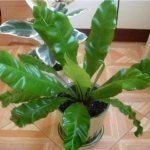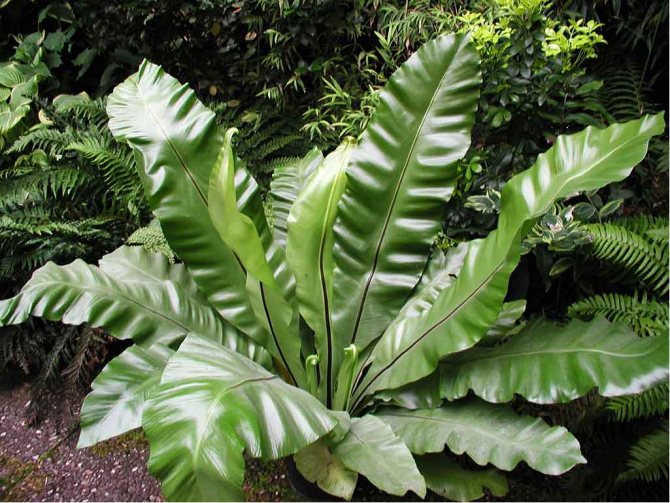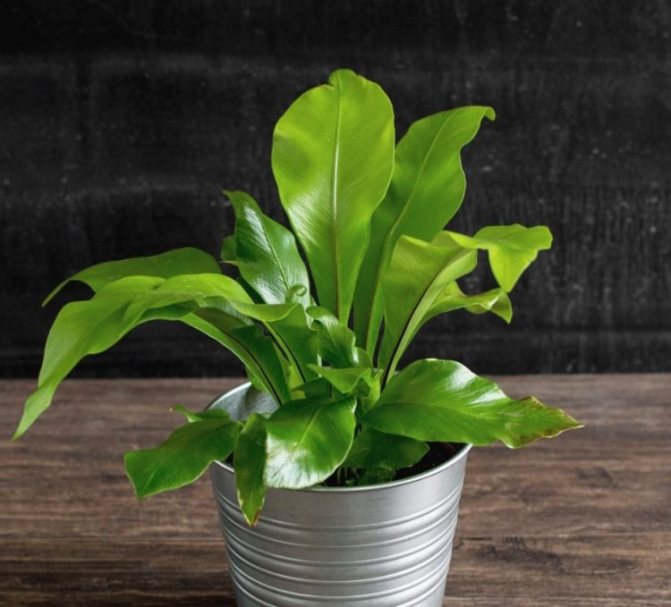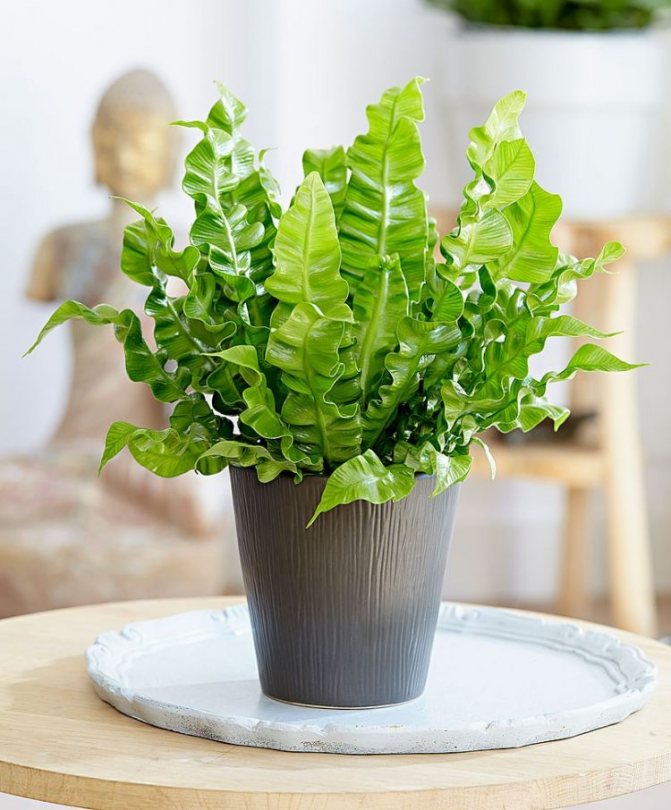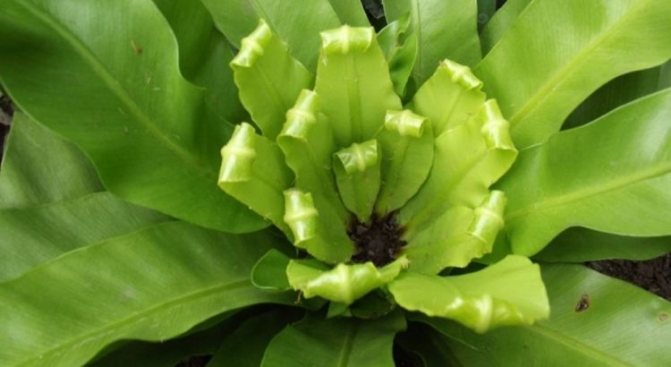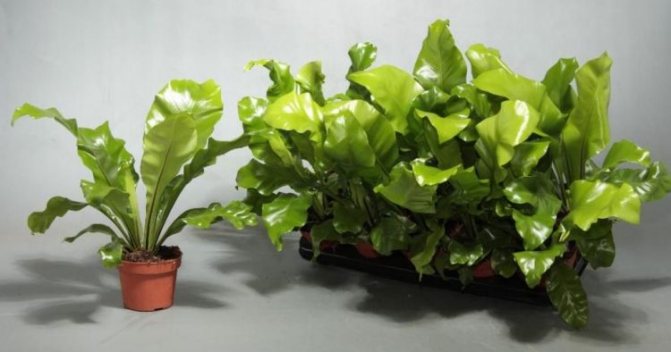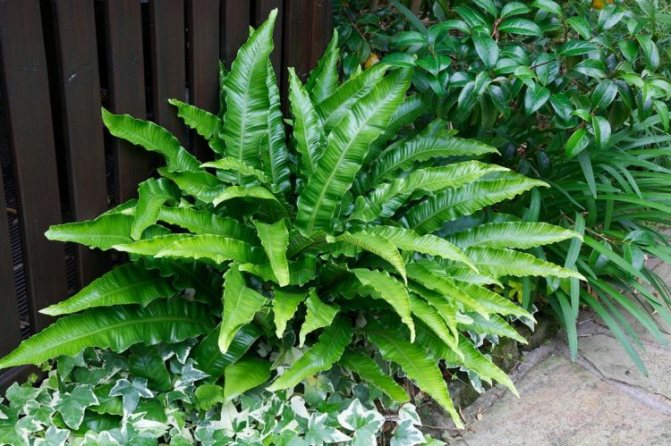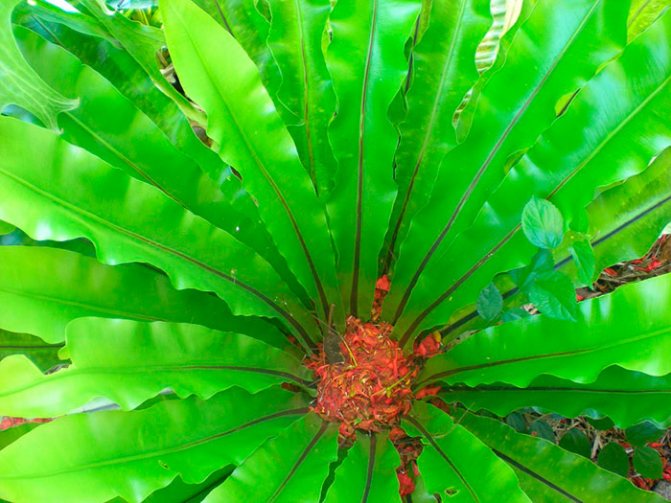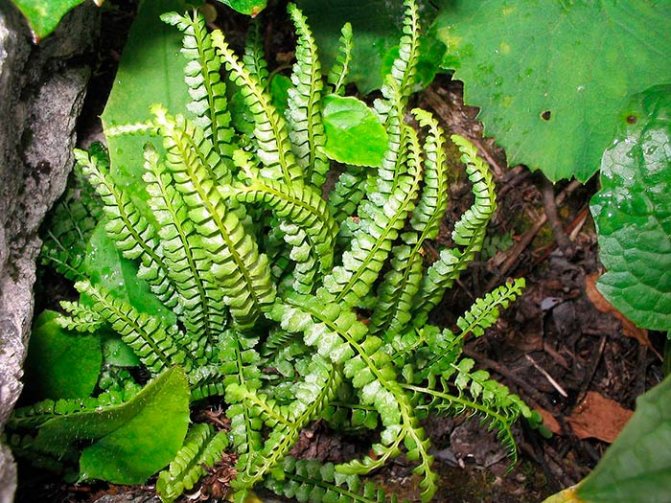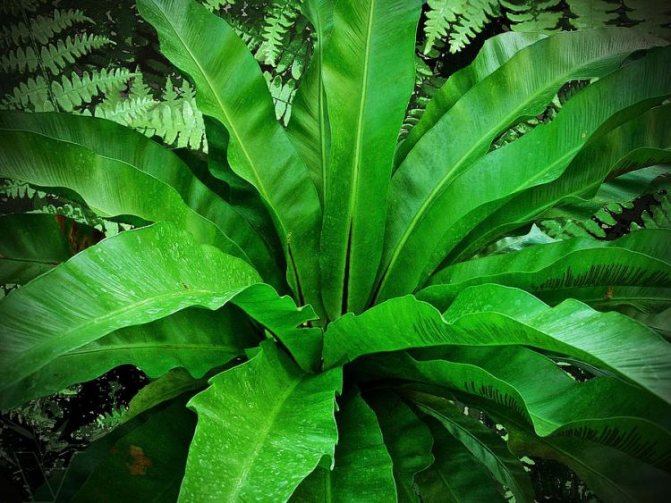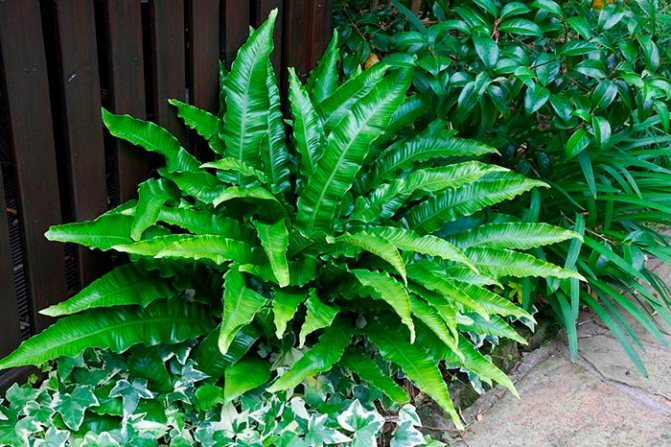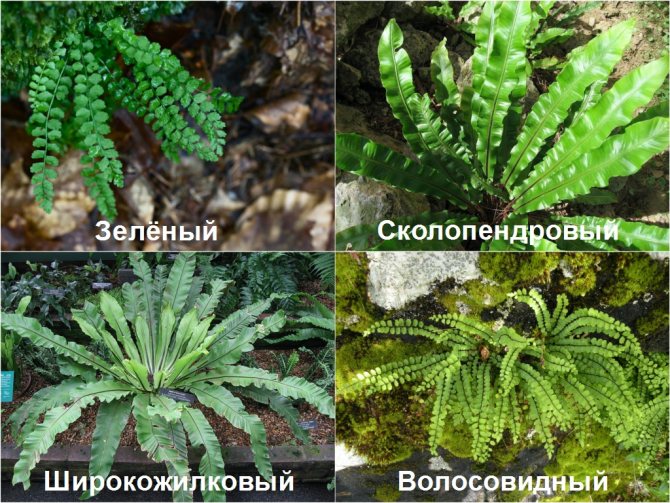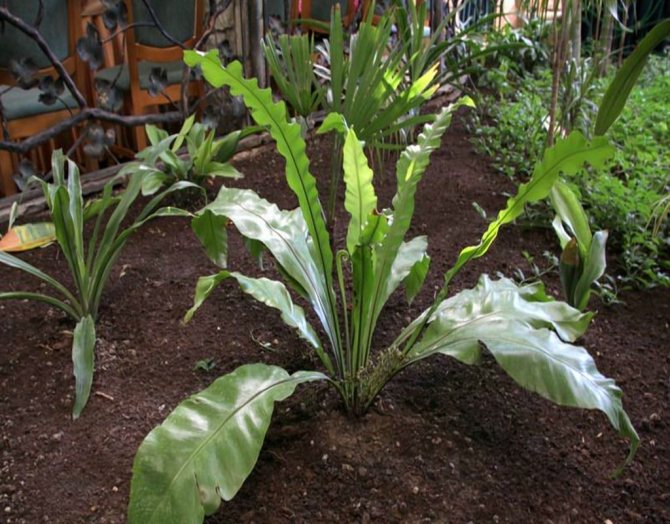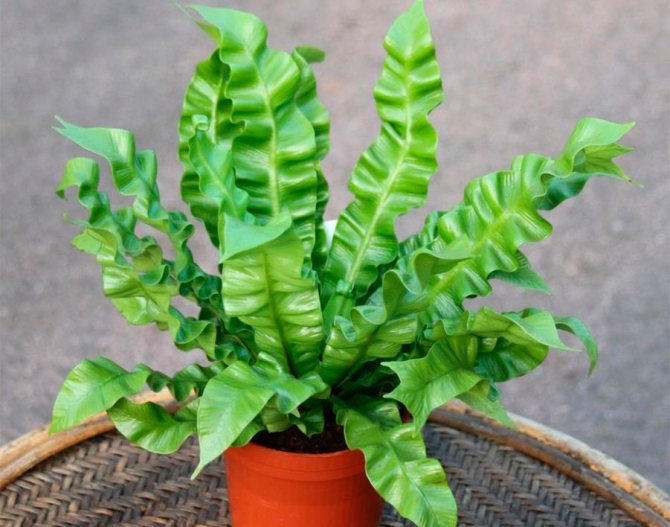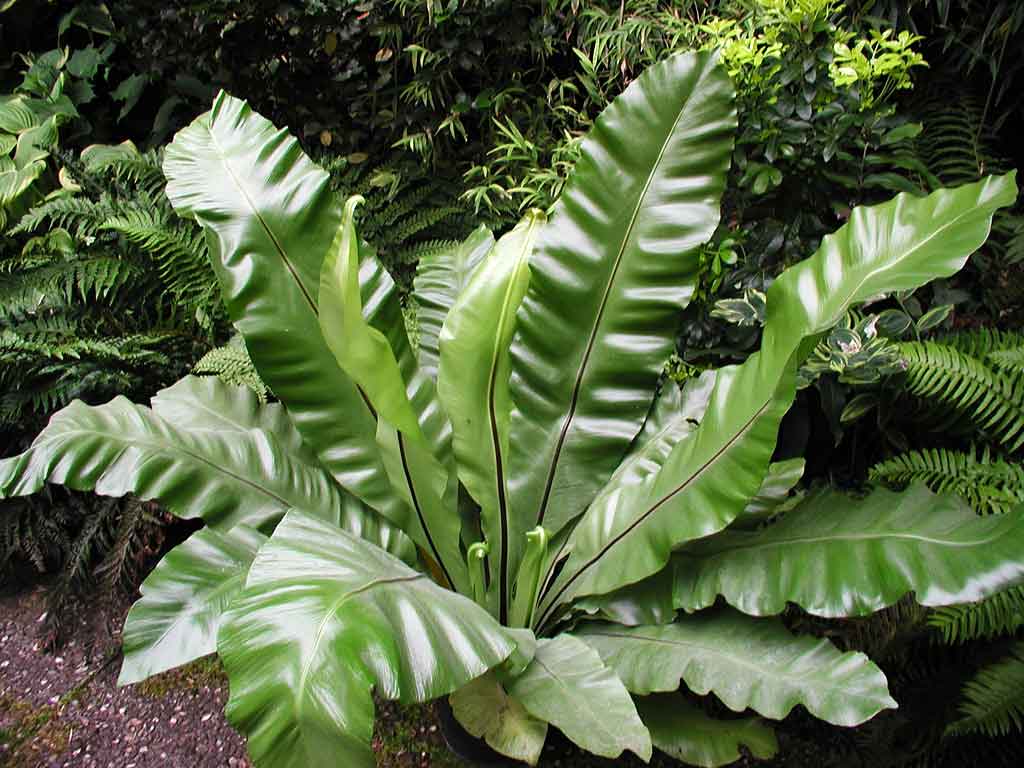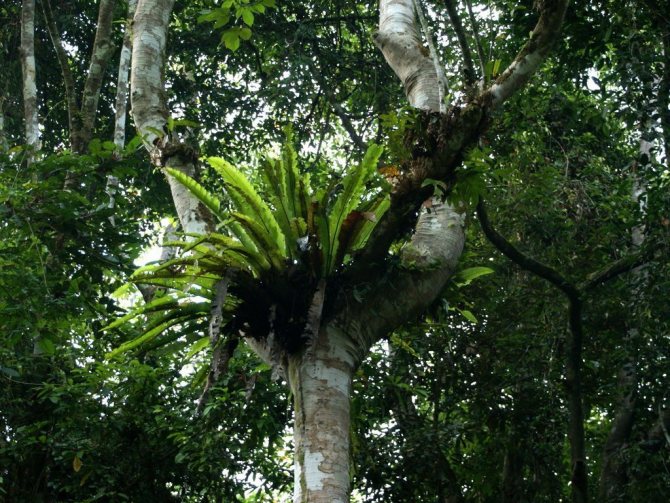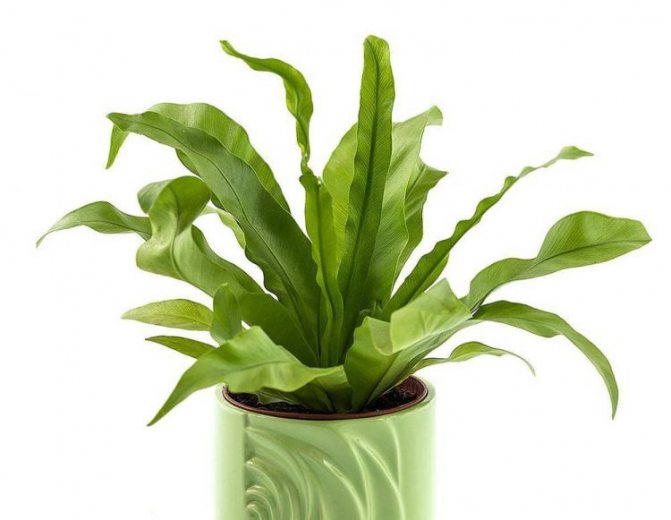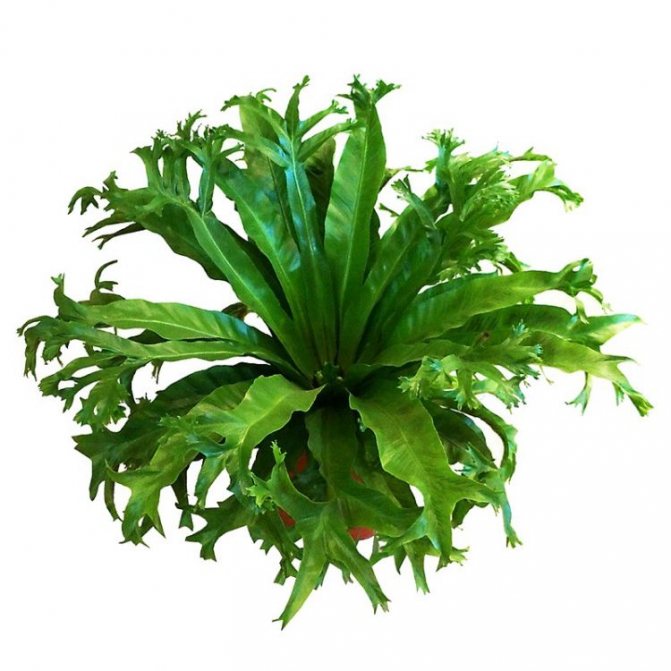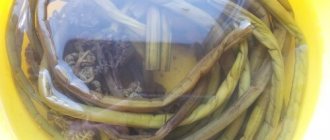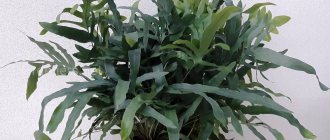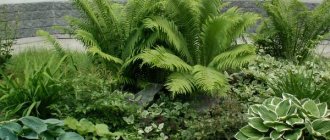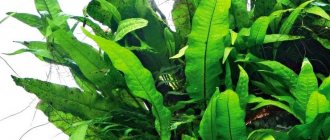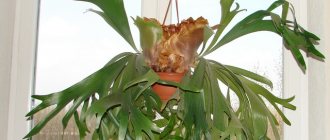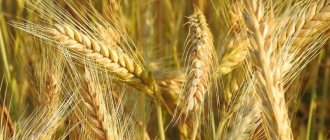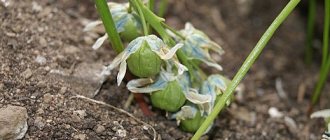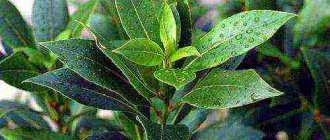A plant like asplenium (Asplenium), which is also called Kostenets, is directly related to the Aspleniaceae family. It belongs to the genus of epiphytic or terrestrial ferns, which are very widespread. Many species of Asplenium are adapted for home cultivation.
This plant in the wild can be found in various parts of the world. So, it can be seen in the tropics of East Africa, New Zealand, Australia, as well as North India.
Popular indoor asplenium species have large, light green leaves of a variety of species that form a rosette. They also have a short and creeping rhizome, on the surface of which there are rather soft scales.
The leaves differ in shape: whole, pinnately dissected, triangular, long xiphoid, and also having wavy edges. Sporangia are located on the lower surface of the leaves.
This plant is easy enough to grow, as long as it is properly cared for. Over the years, this fern grows significantly in width, because new leaves constantly appear from the center of the rosette. Reacts extremely negatively when its foliage is touched.
Description
They are herbaceous perennial plants that can grow in a terrestrial or epiphytic manner. Among them there are evergreen grasses, shrubs and deciduous, which have a very different shape of the rosette.
The leaves of ferns are different in shape: simple dissected, feathery, whole, slightly fleecy and smooth. In shape, they are xiphoid, triangular, forked. Sporangia are present on the underside of the leaves. After all, not a single variety of Aspleniums has flowers. Sporangia are reproductive organs that are located on forked veins. Each leaf rests on a dense petiole, smoothly turning into a leaf blade.
The rhizome in plants is creeping or short, sometimes protruding above the ground, covered with soft scales.
The fern has a height of 30 - 90 cm, and in the case of good care, they grow up to a meter.
Nidusili asplenium nesting is compact and one of the most attractive among non-flowering perennials, with glossy xiphoid leaves of a light green color. The length of the leaves does not exceed half a meter.
The rosette of the perennial nesting variety resembles a nest or a bucket. Of the many indoor fern species, only a few are grown.
General information
This unpretentious plant can be grown both in the garden and as an indoor crop. In nature, ferns reach large sizes, have long feathery leaf plates, cultivated plants are more compact in size, but at the same time they are not inferior in beauty to wild crops.
To grow kostenets at home, you should choose those crop varieties that can grow in tropical climates. They are the perfect option for a potted plant that will not only decorate the interior, but also give it color, allowing you to touch the magic of the tropics at home.
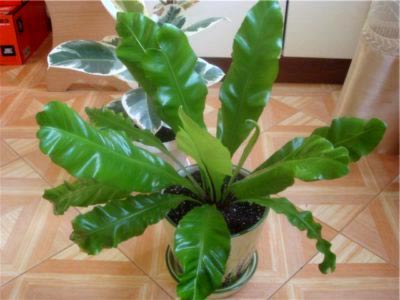
Some species


Bulbous has a very beautiful bush, reaching a height of about a meter. Perennial is distinguished by spreading, feathery, strongly dissected leaves and a dark color.At the base of the leaves, brood bulbs grow, rapidly growing and falling. Falling on wet ground, the bulbs sprout. When the seedlings from the bulbs grow, they are planted. Some of the plants can be left in the old pot to create the lushness of the shrub.
The South Asian perennial is distinguished by its small height and whole leaves, leathery to the touch and wavy in appearance. Their width is about twenty centimeters, and the color is light bright green, a purple vein is visible in the center of the leaf. The rosette of the bush is dense, but rather narrow - funnel-shaped. The root of this variety also differs, it is straight and thick, covered with small scales. Many small adventitious roots, strongly entangled, depart from the root.
Skolopendrovy Kostenets has a glossy leaf surface, solid belt-like shape and a light, bright green hue. The edges of the leaves are wavy or even slightly curly. During development, the leaves are initially vertical, gradually descending and take an arched position. The length of the leaf blades does not exceed 40 cm. The plant is popularly called the "centipede". The perennial, of course, attracts fans of indoor ferns with its short stature, but this shrub has one drawback - it is very tender. You cannot touch it again, the plant dies from frequent touches.
Asplenium fern soil
Fern substrate should be loose, slightly acidic and rich in organic matter. Such a soil mixture can be prepared independently, taking for this sod and leafy soil, humus, peat and sand in a ratio of 2: 3: 3: 1: 1. Also in the ground, the mixture needs to be added charcoal, crushed sphagnum and pieces of clay shards. Such a substrate would be ideal for terrestrial fern species.
For epiphytes, it is necessary to mix sphagnum, peat, coconut fiber and pine bark, and the easiest way is to purchase a ready-made substrate at a flower shop. In this case, a mixture for growing orchids is suitable for earth.


Care features
The indoor flower asplenium attracts plant lovers of this type with its unpretentious care. Therefore, if you want to have in your collection a spectacular beauty asplenium care at home will not bring unnecessary trouble. You just need to remember a few nuances.
Lighting
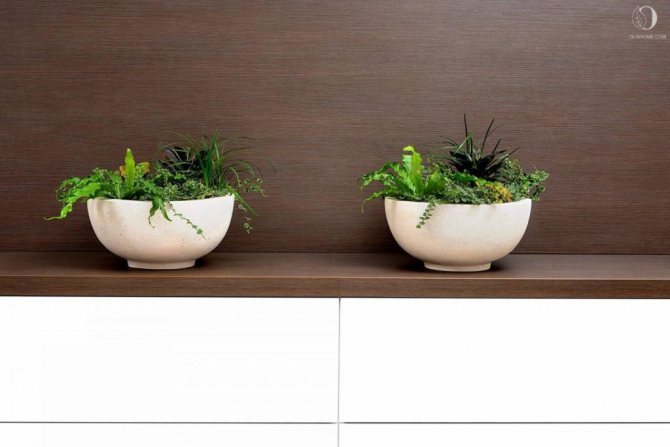

Although Asplenium is a shade-loving one, enough light is needed for its normal development. He feels more comfortable on the windows of the east and west directions. However, the Kostenets does not like direct sunlight. When the sun hits the leaves, they can get burned, and prolonged exposure to rays destroys the plant. It needs shading, but it is also impossible to place a pot with it in the back of the room. The plant stops developing, and the leaves turn yellow.
The soil
Kostenets loves loose and slightly acidic soil. The land should be nutritious, water and air permeable. You can use a special fern mixture for perennials, which is sold in stores. This mixture is easy to prepare yourself. For her they take: leafy soil, peat and humus with coarse sand in a ratio of 3: 2: 1: 1. Instead of leafy soil with humus, you can take sod. Then he, sand and peat are taken equally. A little charcoal, previously crushed, and sphagnum are added to the soil mixture.
Top dressing
You need to feed the kostenets, too, only with the onset of spring and summer, that is, in the season of active development. They are fed every 14 days. For this purpose, complex mineral fertilizer mixtures are used. In autumn and winter, the plant does not need feeding.
An important point in the introduction of dressings is preliminary watering of the soil to avoid root burns.
Temperature and humidity
Asplenium fern belongs to the thermophilic, therefore on summer days the temperature should not be lower than 20 ° C, and in winter it can be lowered to 18 ° C.
The plant requires high humidity. This can be achieved in the same way as when growing other tropical exotics: pour small pebbles, expanded clay or moss into the container, where you need to constantly add water. Also, nesting fern can and should be sprayed in the morning using warm, settled water.
Transfer
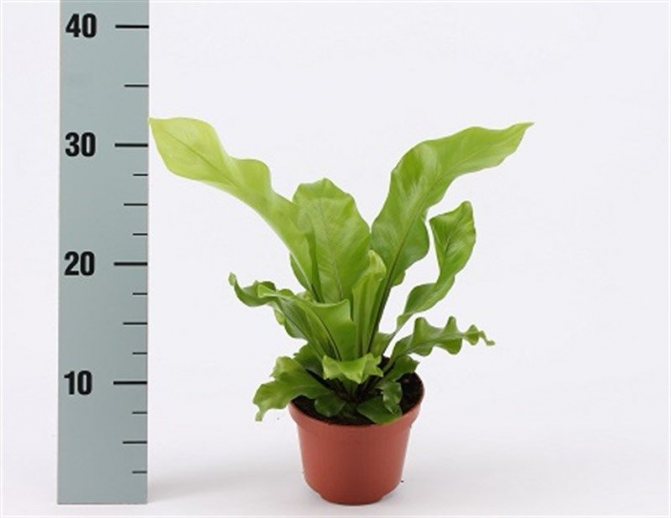

It is better to replant asplenium every year with the arrival of spring. For this purpose, you need to select a pot only slightly larger than the old one. Drainage is “arranged” in the pot and then the prepared mixture is poured. The roots are carefully removed from the old pot, freed from the earthy clod, the entire root part is checked for damage and removed. Only then the bush is transplanted, watered not very abundantly, and then put for a couple of weeks in a slightly shaded place.
Application in site design
Asplenium is widely used in landscape design: its combination with other species and varieties of fern will make it possible to form picturesque compositions. But it should be remembered that undersized species will be lost against the background of tall fern bushes, so the plants should not differ much in size from each other.
Kostenets are planted to decorate rockeries, alpine hills, rocky shores of small artificial reservoirs, borders. It can also be used to decorate spaces on the north side of the garden or summer cottage.
Asplenium is relatively easy to grow. Compliance with all the conditions of planting and care will allow you to acquire an original green garden decoration.
Reproduction
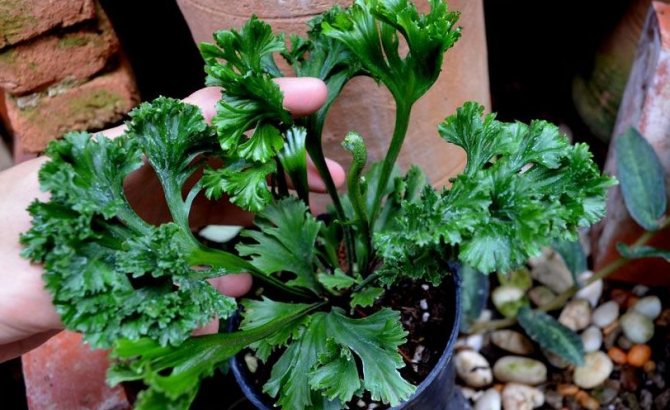

Aspleniums can be propagated in different ways:
- brood buds;
- disputes;
- by dividing rhizomes.
Reproduction by kidneys
In some varieties of kostenets, bulbs or so-called brood buds form at the ends of the leaves. They grow for a while, and then crumble. To get a new fern, you can also separate the bulb and part of the leaf and plant it in a small container with nutritious moist soil. The planted bulbs are covered with glass jars until the roots appear. The jars are periodically removed to ventilate and moisturize the plants. When roots appear and seedlings begin to develop, the jars are removed. Such reproduction is performed in early spring, when the plant is transplanted. For this purpose, the overgrown bone is taken out of the pot, freed from the ground and the root system is divided into parts with a sharp knife blade. Be sure to leave a kidney or a piece of the ground part on each part. Each piece of the bush is placed in a separate pot with loose and moist soil. Reproduction by dividing the roots.
During the first month, delenki grow slowly, during this period they really need spraying with liquid fertilizer solutions. When the seedlings are fully rooted, you need to care for them in the same way as for adult ferns.
Reproduction by spores
This method is the most difficult and time consuming in comparison with the others. But there are times when you can't do without it. This is done at the beginning of the first spring month. Before starting the germination of spores, it is necessary to create the required temperature regime: 22 ° C.
With this reproduction, choose the largest leaf on which there are ripe spores, cut it off and scrape the spores onto a piece of paper. The sowing soil must be disinfected. To do this, you can bake it in the oven.
A drainage layer is poured into the sowing container, and then the soil is carefully watered. Then the container is placed in a dark place, covering the container with glass. Every day, for a while, the glass is removed to ventilate and re-moisten the dried earth. Seedlings will appear no earlier than in two to three months. And throughout this period, the seedlings are kept in the dark and at the specified temperature.After the spores have sprouted, the glass is removed, and the container is transferred to a lighted place, and it is better to maintain the same temperature. The grown seedlings are thinned out, leaving one at a distance of 3 cm, leaving the strongest plants. And after a month, each fern is planted in a separate pot.
Watering asplenium
When choosing an irrigation regime, you should take into account the condition of the soil. Its surface should always be moist, but there should be no stagnation of moisture.
Also, experienced flower growers recommend pouring half a glass of settled or purified warm water into a pot with a plant every two days. In the summer, the fern should be watered up to twice a week, and in the winter, watering should be reduced to once a week.
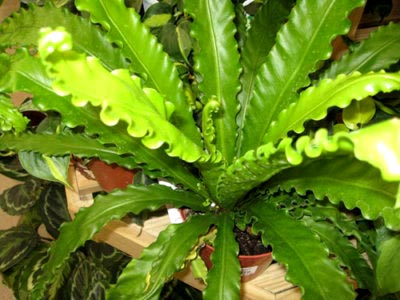

Diseases and treatment
If the leaves of a plant lose their brightness or are burned by the sun's rays, it is necessary to shade the bone.
- The ends of the leaves dry out and have a brown color - this often happens when there is a lack of air humidity. In this case, it is enough to spray the perennial more often. With sufficient humidity in the air and soil in the pot, this phenomenon can be a signal of the appearance of rot on the roots. Then you need to regulate the humidification mode.
- Rolling leaves with spots, such a phenomenon indicates insufficient room temperature or that the plant is placed in a draft. To cure it, it is enough just to move the perennial to conditions that are more comfortable for it.
- Spots on the leaves, this happens with improper use of fertilizers and fertilizers. In this situation, you should change the feeding regime and carefully read the instructions for their use. It is even possible that the fertilizers used are not suitable for the fern. Stains can also appear after using the gloss.
Diseases and pests
The weakening of the plant's immunity, which leads to the development of diseases, is often the result of improper care.
Common diseases are gray rot and leaf spot. When infected with gray rot or when spots appear, the diseased parts of the plant are removed, the bush is treated with a fungicide.
Rock ferns are rarely attacked by pests, but this possibility cannot be completely ruled out:
- Nematode - causes the appearance of brown spots on the leaf plates. It will not be possible to cure, the infected plants are recommended to be destroyed immediately so that the disease does not spread further.
- Shield - sucks out cell sap, therefore, over time, the leaves lose their bright color and begin to dry. To cure the fern, they are treated with an insecticide, but use it with great care.
- Spider mite... One of the signs of infection is the spider web on the leaves. It is removed, the bushes are sprayed with water to wash away the traces of the insect's activity.
- Aphid... The bush is washed with soapy water, sprayed with ash or tobacco infusion.
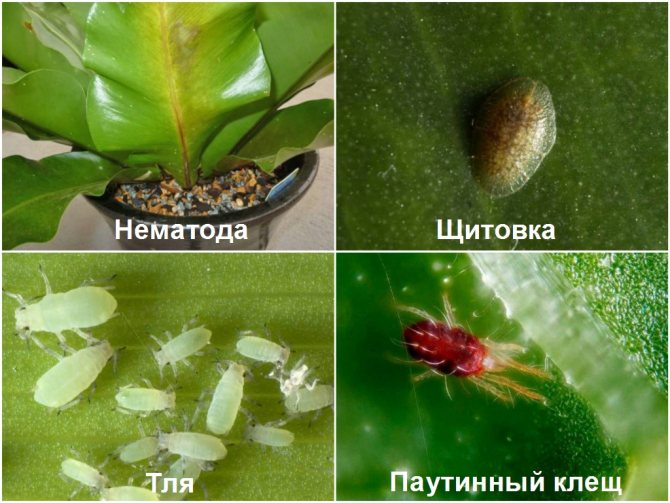

Diseases and pests
Temperature
Asplenium nesting is a tropical plant, so for proper development it requires an appropriate temperature, while maintaining the moisture not only of the soil, but also of the air. The species grows well at room temperature 18-24 ° C, it is worth taking care that in winter the temperature does not fall below 16 ° C, preferably about 18 ° C.
It is worth emphasizing that in addition to a warm room, the plant also prefers a warm substrate. This requirement leads to the fact that the temperature in winter should not fall beyond the mentioned boundaries. If the apartment has underfloor heating, this will have a positive effect on the plant.
Where does asplenium grow and what is it also called?
The genus name comes from the Greek words a - not and splen - spleen and is associated with the alleged medicinal properties of these ferns.
And what else is the asplenium flower called? In Russia, he is referred to as "Kostenets".
Where asplenium grows, it is always hot and humid: these are the rainforests of Asia, Africa and Australia.Gradually, the plants spread to North America, Europe, mountainous regions and foothills of the Caucasus, etc. A perennial plant from the temperate regions of both hemispheres. Height from 20 to 100 cm.
Herbaceous perennial plants aspleniums are distributed throughout the globe, very diverse in habitats: from rocky cracks and tree branches to a dense forest canopy. The fern is a bush with xiphoid fronds, which, together with a scaly rhizome and tangled roots, form a kind of "nest". He is unpretentious, but one should not touch young fronds.
It is an epiphytic fern that grows naturally on the trunks and branches of trees.
The nesting asplenium flower has a thick, straight rhizome and leathery, whole, very large leaves.
In culture, there is another, completely different species - this is asplenium onion-bearing (A. bulbiferum) is a plant with feathery, strongly dissected leaf blades. New young plants develop on mature leaves.
Plant species asplenium and their characteristics
The most popular are the following types:
Asplenium antique 'Osaka' (A. antiquum ‘Osaka’)
Asplenium nesting (A. nidus)
Asplenium nesting ‘Fimbriatum’ (A. nidus 'Fimbriatum')
Asplenium viviparous (A. viviparum)
Asplenium south asian (A. australasicum)
Asplenium (bone) hairy - Asplenium trichomanes
It is found naturally in North America, Western Europe, and the Caucasus. The plant is 15–35 cm high.
It is a moisture-loving, shade-loving and relatively thermophilic plant. It is widespread in the lower forest belt of the Caucasus Mountains, where it forms whole thickets along limestone rocks in gorges. Absolutely winter-hardy. One of the most graceful ferns with evergreen pinnate, rounded leaves 10–20 cm long, extending from a short rhizome.
Look at the photo - in this type of saplenium, the leaf petiole is dark brown, the leaves are round-ovoid, toothed, dark green:
On their underside there are oblong sori with spores. This species has a peculiar smell. The root system is fibrous, weak. Of all the species, it is the most unpretentious in culture. In Ukraine, it grows well under the canopy of an oak tree, which provides its shelter in winter with fallen leaves, on ordinary garden soils. Can be planted in rock gardens in crevices between stones. Its graceful sod grows quickly and can be divided in 3-4 years. Dividing and replanting is best done in the spring. Prefers an alkaline environment, therefore limestone, sandstone or tuff is desirable for it.
Transplant does not require many years. Moisture-loving, but dies in poorly drained areas. Winter-hardy under snow cover.
Asplenium nesting - Asplenium nidus
Homeland - the territory from East Africa and the island of Madagascar to the Malay Archipelago and the Hawaiian Islands. Like other tropical ferns, the indoor flower asplenium can be cultivated in rooms and greenhouses by shading from direct sunlight and spraying frequently. He is an epiphyte.
Asplenium nesting - a very interesting fern that prefers keeping in the shade and moist air. Its elongated xiphoid frond is up to 15–75 cm long, 5–10 cm wide, bright green, whole, leathery, xiphoid, their edges are wavy, the midrib is brown. They are collected in a wide-open socket, like a nest, which in natural conditions accumulates moisture, plant debris and dead insects.
This epiphytic fern resembles bromeliads with its rosette rosette. Fern nesting bone is a fast-growing plant. With good care, its leaves reach 100 cm in length. With age, it grows greatly in width, since new fronds are constantly formed from the center of the rosette.
The plant prefers shaded areas. Asplenium nesting withstands bright light, but in the sun its fronds turn pale and lose their luster.This fern tolerates a fairly wide temperature range. In winter, the optimum temperature is 15 ° C. In summer, the temperature for the nesting bone plant should not exceed 21-24 ° C. At temperatures above 20 ° C, you need to maintain a high soil moisture by watering the plant two or three times a week. At low temperatures, it should be watered every 7-10 days.
Asplenium viviparous - Asplenium viviparum
Fern up to 60 cm tall. Fronds short-petiolate, double- or four-pinnate, 40-60 cm long, 20 cm wide; the segments are narrow, almost filiform. Designed for keeping in spacious rooms with north or east orientation windows; in greenhouses, winter gardens. It grows well on a substrate rich in humus, the optimal composition of the soil mixture is leafy soil, peat, tree bark (1: 1: 1) with the addition of charcoal, pH is slightly acidic, neutral. It is rarely transplanted, usually in the spring as needed, using a larger pot (3-5 cm) in diameter.
Asplenium bulbiferous - Asplenium bulbiferum
It is a fern that lives in the lower tier of the eucalyptus forests of Australia and New Zealand. This species has triple-pinned fronds, on the upper side of which brood buds (bulbs) are formed, for which it got its name, and its stems look like a wire. This herbaceous plant can grow up to 120 cm in height. The frond segments resemble viviparous asplenium in shape, but they are larger. Water the plant from above, since the root system is superficial, or by immersing the pot in a container of water. Asplenium leaves do not tolerate Leaves Glitter.
You can limit the growth of a fern by keeping it in a cramped pot. Asplenium grows pretty quickly: in one season, the bush can reach the size of an adult specimen. It grows well in a mixture of leaf, turf, peat, humus, sand (1: 1: 1: 1: 1).
Humidity: increased.
Temperature: 16-21 ° C.
Watering: regular, moderate in winter, do not dry out.
Top dressing: once every 3-4 weeks with semi-concentrated fertilizer in spring and summer.
Reproduction: spores, brood buds, often forming on the upper part of the leaf (in greenhouses at a temperature of 20-24 ° C).
Asplenium bulbiferous - almost frost-resistant plant and withstands temperatures around 5-7 ° C in winter. In summer, the temperature for asplenium bulbiferous should not exceed 18 ° C. At temperatures above 20 ° C, you need to maintain a high soil moisture by watering the plant two or three times a week. At lower temperatures, it should be watered every 7-10 days.
In summer, asplenium needs to be fed with half the recommended dose of fertilizer for indoor flowers. Looks great in light, warm rooms, offices, winter gardens and floral arrangements. Easily propagated by spores that germinate at 20 ° C and by brood buds.
Asplenium centipede - Asplenium scolopendrium
Natural area of distribution - North America, Europe, Transcaucasia, Ciscaucasia. Plant height - 45-70 cm.
As you can see in the photo, the asplenium flower of this species forms an irregular rosette in the form of a cock's comb:
Vayi are bright green, leathery, glossy, belt-shaped with a heart-shaped base. Loves places near waterfalls and streams. He needs a well-drained fertile soil.
Shade-tolerant, like most ferns, frost-hardy. Propagated by division of bushes and spores.
Wall asplenium - Asplenium rutamuraria
Occasionally found in all countries of the Northern Hemisphere. It grows on the stone walls of old buildings (that's why it is called masonry), rocks. In nature, the plant is found in sunny and shady places, but invariably on a limestone substrate, often even in the seams of the walls. Winter-hardy. Perennial. The rhizome is shortened, branched, completely covered with remnants of leaf petioles and thin entangled roots, and on the tops with black-brown linear-lanceolate films.
Pay attention to the photo - the Asplenium fern of this species has numerous leaves, 3–12 cm long and 1–3 cm wide, thick and tough, grayish green:
Leaves overwinter on long green, brownish petioles at the base, with sparse brown films. The feathers are alternate, 3-5 on each side, the upper ones are simple and sessile, the rest are trifoliate or pinnately dissected. Sori linear. The spores are almost spherical, folded and wrinkled.
It is undemanding to moisture and soil (although it prefers alkaline and neutral) fern. The main condition is good drainage. With a lack of moisture, the leaves curl and unfold again with increasing moisture. Shade-loving - in open places it becomes miniature.
Propagated by dividing the bush in the spring at the beginning of growth and by spores. Winter-hardy under snow cover. Often it does not take root well and grows slowly in culture.
Asplenium South Asian (A. australasicum (J. Sm.) Hook. (A. nidus L. var. Australasicum J. Sm.)
Epiphytic plant with large leaves, up to 1.5 m long and 20 cm wide, collected in a dense, more or less narrow funnel-shaped rosette. The rhizome is straight, thick, covered with scales and many tangled adventitious roots.
In the photo of this species of bone, it is noticeable that its leaves are whole, sometimes incorrectly cut, reverse lanceolate:
Leaves with the greatest width in the middle or slightly above the middle of the blade, rather sharply tapering downwards into a very narrow base, leathery, slightly wavy, light green with a dark purple midrib, sharp-tipped below. Sori linear, elongated, obliquely located in relation to the midrib. Homeland - Australia, Polynesia.
The plant is kept in winter at a temperature of 18-20 ° C, A. onion-bearing - 14-16 ° C. Asplenium South Asian is a light-loving plant, while the first two species can tolerate significant shading.
Altai asplenium - Asplenium altajense
Homeland - Altai, Krasnoyarsk Territory, Buryatia, mountain steppes and forest-steppes of Southern Siberia and Mongolia. Grows on rocks (often shady). Perennial. The rhizome is shortened, soddy. Leaves 5–7 cm long and 2–4 cm wide, broadly lanceolate, dark green, glabrous, with prominent veins on top.
Look at the photo - the petioles of the asplenium (kostenets) are green, broadly grooved:
Feathers 6-12 pairs, feathers oboval, wedge-shaped to the base, serrated-incised, on short petioles. Spores with folds and small spines.
Asplenium north - Asplenium septentrionale
Rock fern, rarely found in rock crevices of the forest belt of Europe and Asia. Winter-hardy. The plant is perennial, the rhizome is short, branched, with numerous remnants of petioles and tangled roots. Leaves are numerous, leathery, hibernating, 4–13 cm, glabrous, on long petioles. The leaf blade is 2–4 times shorter than the petiole, divided into 2 narrow segments and with a petiole, at the apex and on the sides with 3–5 long and narrow teeth. Sori linear and long. Spores are oval-reniform, folded-wrinkled.
Propagated by dividing the bush in the spring, at the beginning of growth, and by spores. The plant can be planted both in a sunny place and in the shade; does not tolerate limestone soils, direct sunlight and overdrying. He does not like transplants with root damage, but, in general, grows well in culture. Winter-hardy under snow cover.
Asplenium black - Asplenium adiantum-nigrum
It grows on shaded rocks, often with a predominance of silicon in the rock, in Central Europe and the Mediterranean, in the Carpathians, in the Crimea, in the Caucasus, in the Tien Shan. Less winter-hardy than the species described above.
Height 10–40 cm. Leaves are hard, leathery, overwintering, double-pinnate, triangular in outline, on dark brown petioles. Freezes in severe frosts without snow. It grows better in partial shade, with normal moisture, on fertile, with the addition of coarse sand, neutral soil. For the winter, it is good to cover with fallen leaves or spruce branches.
Next, you will learn how Asplenium reproduces and how to care for it at home.
Energy of an ancient life form
The asplenium plant (kostenets) is a whole genus that includes more than 400 species of ferns of the Kostentsov family.For thousands of years, ferns have inhabited the Earth and are the oldest representatives of life on the planet.
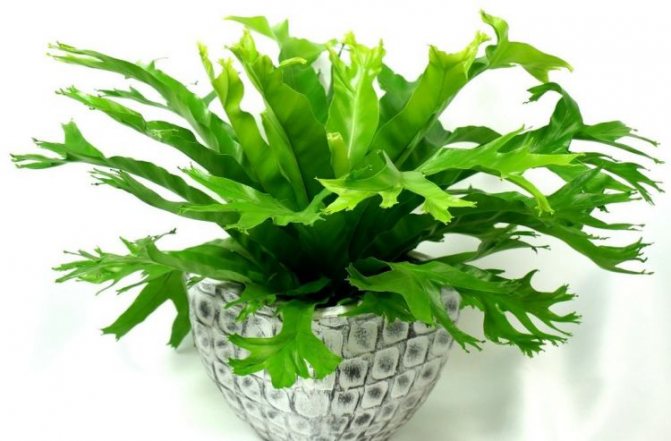

They went through many natural disasters long before the appearance of man. We have absorbed the ability to survive in the most extreme conditions with the evolution.
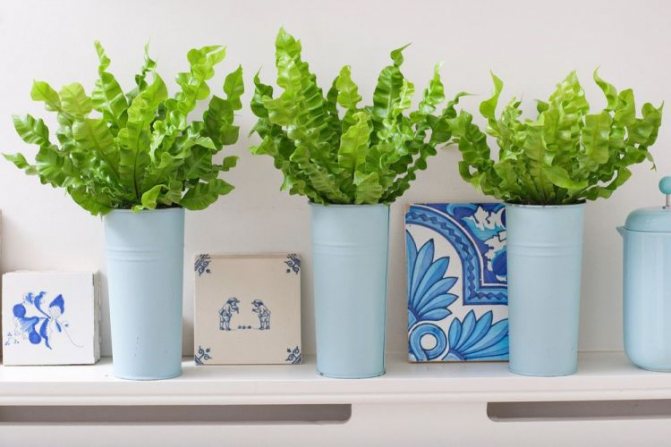

Esotericists believe that the presence of ferns in the space of a person's dwelling stabilizes the emotional background of the inhabitants.
Smoothing out chaotic surges of energy can improve mood, help people stop worrying about trifles and get creative.
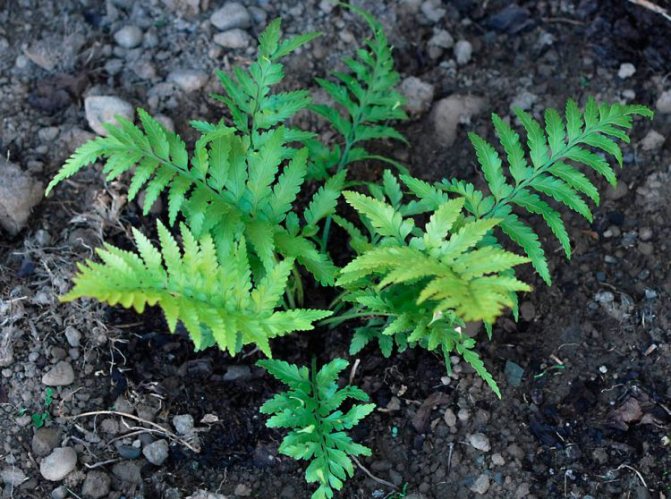

Asplenium greens contain no harmful and toxic substances. It can be placed in any living space without fear for the health of household members.
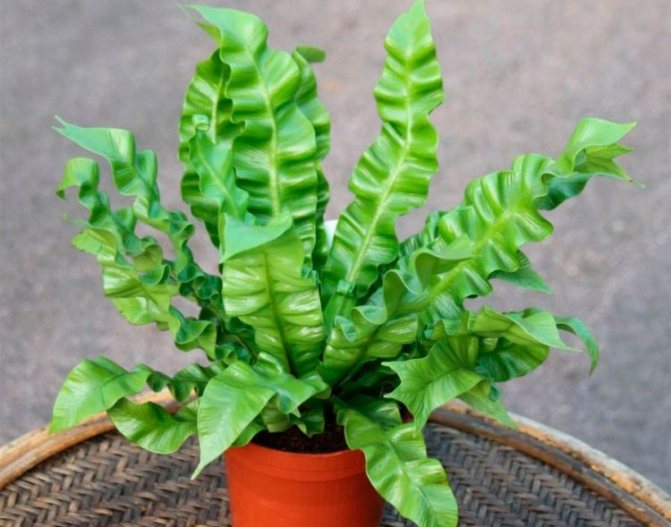

Thanks to the presence of a fern in the space of the house, you will more easily open up to everything new in life and master new knowledge.
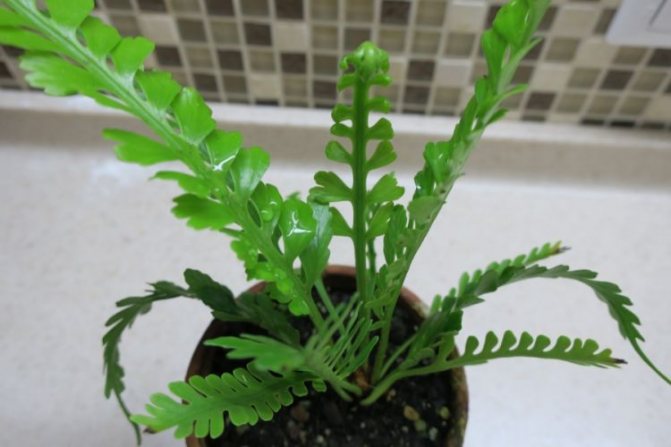

Other species grown in apartments
Asplenium breeding is not the only representative of the genus Kostenets (Asplenium), it is worth familiarizing yourself with some species that look just as interesting and, of course, are worth our attention.
Carrot-leaved bone marrow (Asplenium daucifolium)


With feathery leaves. Grown in permeable soil with high moisture content. Carrot-leaved kostenets does not require high temperatures. During the growing season, the temperature is 18-20 ° C, and in winter about 15 ° C.
Kostenets or Asplenium bulbiferum


The flower is also decorative, but very different from A. nesting with leaves and the presence of so-called propagules on the leaves. The species prefers higher temperatures, but also requires more air humidity. To preserve the plant, it is necessary to provide it with a temperature of about 18 ° C and high air humidity, it cannot do without spraying with soft and settled water, in addition, the pot should be installed on a stand with wet expanded clay. Of course, it was easier to grow Asplenium bulbiferous in a greenhouse, since in this case it is easier to provide optimal conditions.
Kostenets or asplenium ancient (Asplenium antiquum)


One of the most decorative ferns. The 'Osaka' variety has slightly corrugated edges. As demanding as A. nesting. The main requirements are, first of all, high air humidity, a well-drained base, as well as temperature. Asplenium is ancient, just as A. nesting is an epiphyte.
Resting Asplenium Care
Fern care during dormancy varies slightly. First of all, it is necessary to reduce watering and reduce the temperature in the room to 16 degrees.
Feeding and washing of leaf plates under the shower should be excluded. You can only spray and wipe the leaves with a damp sponge.
Air humidity should remain within 70%. With the onset of spring, it is necessary to return to the standard asplenium care scheme.
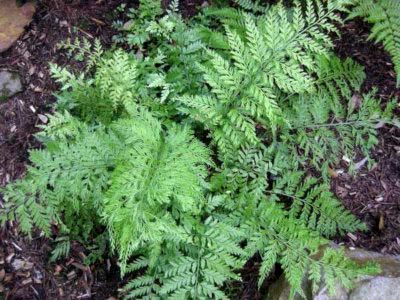

Watering and humidity
The flower needs high humidity, so if you make mistakes at this stage, problems may arise.
For irrigation, use only soft water, for example, boiled or settled, as well as summer rainwater. During the growing season, the plant should be provided with a constantly moist substrate, but not wet, and in winter, at low temperatures, it is better to water carefully and let the soil dry slightly between waterings.
Spraying the plant is also important to provide the plant with adequate moisture. In addition, the container with the plant should be placed on a stand filled with wet expanded clay.
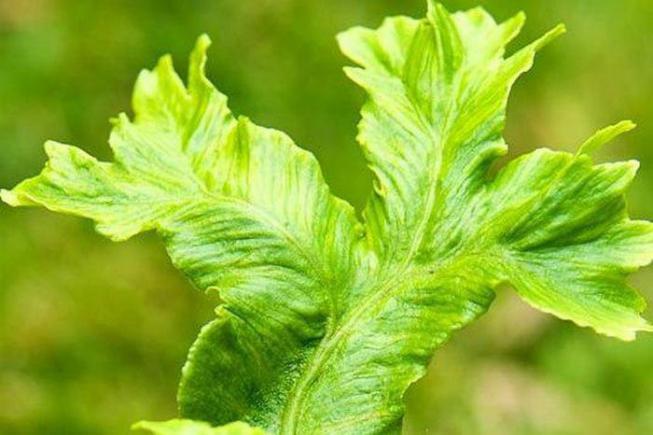

Fertilizer for asplenium
Young plants that are in the phase of active growth and shoot uplift are especially acutely in need of feeding. Fern vegetation lasts from April to late September.
During this period, it is necessary to apply top dressing twice a month at the root, along with water for irrigation. Adults aspleniums are fed once a month throughout the summer with preparations for indoor plants.


Possible growing difficulties
There are situations when the tips of the leaf plates begin to dry out, which spoils the appearance of the fern. In order for the plant to recover, it is necessary to increase the level of air humidity by spraying. If the leaves lose their natural green color, becoming pale, then this indicates the occurrence of a burn. A pot with an ornamental crop should be placed in the shade. If spots are found, then you need to correct the temperature regime, the room is too cool.
Asplenium is an exotic plant with high decorative characteristics. He is able to effectively decorate the room and purify the air. When growing it, special attention should be paid to the level of humidity in the room, temperature and illumination indicators. Only a competent approach is the key to the health of the fern.
The choice of capacity, soil, transplant
As soon as the quarantine time has passed, the asplenium must be immediately transplanted into a separate container. A lump of earth with roots should be left, only slightly shaking off excess soil.
Young plants will have to be transplanted every year, preferably in spring. Grown up - rejuvenate every 2 years. The pot for planting should be selected larger than the previous one, but not huge, the Kostenets will not like this. The container must be selected with holes.
The soil is suitable for planting orchids. This mixture is easy to make yourself. Soil composition: peat, sand, pine bark, humus and charcoal.
Step by step transplant:
- Pick up a pot with holes for air, pour drainage on the bottom.
- Put the substrate on top, it should remain loose.
- Remove the bone from the pot with a lump of earth on the roots and put it in another container. Remove the black roots before doing this.
- Cover with a portion of the substrate on top and tamp lightly at the roots.
- Afterwards pour with lukewarm water and spray with a spray bottle.
- Remove the pot for a while in a dark place.
Lighting
Adequate lighting for the plant should reflect the conditions that existed in its native land. The lighting cannot be too bright or too dark. The main thing is that the plant is protected from direct sunlight. When choosing a permanent place for a flower, do not forget about the need to provide the plant with an appropriate level of moisture.


Asplenium transplant
It is necessary to replant the plant so that it does not hurt and grow well. This procedure is carried out every year or every two years. During transplantation, it is necessary to remove the dead parts of the root system, and the rest should be handled very carefully to avoid damage, since it grows very slowly and if its integrity is violated, the fern will hurt for a long time or even die.
The transplant is carried out in the spring, choosing for this a shallow pot with a loose, moist substrate corresponding to the type of plant. Acclimatization after the procedure takes about a month.



